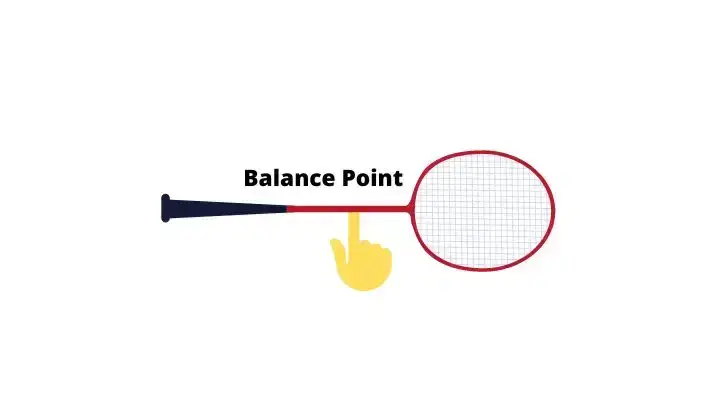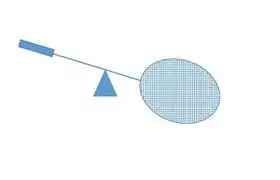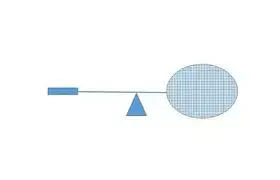Badminton is an indoor sport played using a racket and a shuttlecock. The racket is your most crucial piece of equipment. But first, you need to understand various parts of the badminton racket, as it plays a significant role in hitting the shuttlecock back and forth. A racket generally has five parts: a stringed area, head, throat, shaft, and handle. The upper part of the racket is called the frame, which measures 680 mm in length and 230 mm in width.
Another crucial thing in a badminton racket is its balance point. The equilibrium point of the racket is a crucial component to pay attention to when purchasing a badminton racket. Along the racket’s shaft is where the balance point is situated. It is merely the point at which the racket may balance on your finger.
Therefore, players must always choose an ideal racket according to their gameplay level. And the type of racket you choose should match your playing ability.
Also read: How to choose a perfect badminton racket?
So, let’s begin and discuss more about the balance point of a racket:
What is the balance point of a racket?
The weight distribution of a badminton racket is referred to as its balance. The balance point serves as a representation of this. This point designates the region where the racket can be supported at the shaft without leaning too far to one side.
If a racket is balanced correctly, it will be clear whether the head or handle is heavier. Weight symmetry, or the fact that the racket’s weight is the same throughout its components, characterizes even-balanced rackets.
Rather than this, the balance point is typically expressed in millimeters (mm) from the bottom of the racket’s handle.
Types of balance point in a badminton racket
Generally a racket is categorized in three balance points:
1. Head-heavy balance

A racket with a head-heavy balance has more weight towards the head of the racket. This type of balance provides more power in your shots, making it suitable for players who prefer aggressive and powerful gameplay.
2. Head-light balance

A racket with a head-light balance has less weight towards the head and more towards the handle. This balance allows for faster racket maneuverability, making it suitable for players who rely on quick reactions, control, and defensive play.
3. Even-balance

An even-balanced racket has its weight evenly distributed throughout the length of the racket. This balance offers power and control, making it versatile for various playing styles.
How to check the balance of a racket?
To check the balance point of a badminton racket, you can follow these steps:
- Locate the Balance Point Scale: Many badminton specialty stores or sports equipment shops have a balance point scale specifically designed for rackets. It typically consists of a horizontal rod with markings indicating the balance point in millimeters.
- Balance the Racket on the Scale: Hold the racket by its handle horizontally and gently place the bottom of the handle on the balance point scale. Ensure that the racket is level and not tilted to one side.
- Observe the Balance Point: Look at the scale and note the measurement where the Racket’s balance point aligns. This measurement is typically in millimeters and indicates the distance from the bottom of the handle to the balance point of the Racket.
- Determine the Balance Type: Based on the measurement; you can categorize the Racket’s balance as head-heavy, even balance, or headlight. The exact classification may vary depending on the manufacturer, but generally:
- If the measurement is greater than 295mm, it is considered head-heavy.
- It is considered an even balance if the measurement is between 285mm and 295mm.
- If the measurement is less than 285mm, it is considered a headlight.
Additionally, it’s important to note that the balance point can vary slightly depending on factors like string tension, grip type, and additional modifications made to the Racket. Therefore, checking the balance point before purchasing a racket or after any modifications is a good idea.
Final Words
The balance point of a badminton racket refers to the point where the weight is evenly distributed along the racket’s length. It significantly determines the racket’s characteristics, such as power, control, and maneuverability. The balance point can be categorized as head-heavy, even balance, or head-light, each offering different advantages depending on the player’s style and preference.
And to check the balance point of a badminton racket, you can use a balance point scale specifically designed for rackets. By balancing the racket horizontally on the scale and observing the measurement where the balance point aligns, you can determine the type of balance the racket possesses.
Also, remember that personal preference and playing style are crucial factors in choosing a racket. Try out different balance points and racket types to find the one that suits you best. Consulting with experts or experienced players can also provide valuable insights when selecting a racket.
